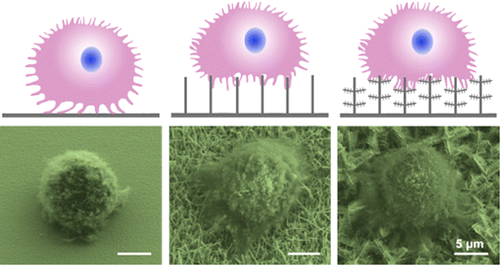Hierarchical Nanowire Arrays as Three-Dimensional Fractal Nanobiointerfaces for High Efficient Capture of Cancer Cells
Feilong Zhang, Yan Jiang, Xueli Liu, Jingxin Meng, Pengchao Zhang, Hongliang Liu, Gao Yang,Guannan Li, Lei Jiang, Li-Jun Wan, Jin-Song Hu, and Shutao Wang
Nano Lett., 2016, 16 (1), pp 766–772
DOI: 10.1021/acs.nanolett.5b04731
Publication Date (Web): December 16, 2015
Abstract (click for pdf file)

A hierarchical assembled ITO nanowire array with both horizontal and vertical nanowire branches was fabricated as a new three-dimensional fractal nanobiointerface for efficient cancer cell capture. Comparing with ITO nanowire array without branches, this fractal nanobiointerface exhibited much higher efficiency (89% vs 67%) and specificity in capturing cancer cells and took shorter time (35 vs 45 min) to reach the maximal capture efficiency. As indicated by the immunofluorescent and ESEM images, this enhancement can be attributed to the improvement of topographical interaction between cells and the substrate. The introduction of horizontal and vertical nanowire branches makes the substrate topographically match better with cell filopodia and provides more binding sites for cell capture. The live/dead cell staining and proliferation experiments confirm that this fractal nanobiointerface displays excellent cyto-compatibility with an over 96% cell viability after capture. These results provide new insights and may open up opportunities in designing and engineering new cell-material interfaces for advanced biomedical applications.
